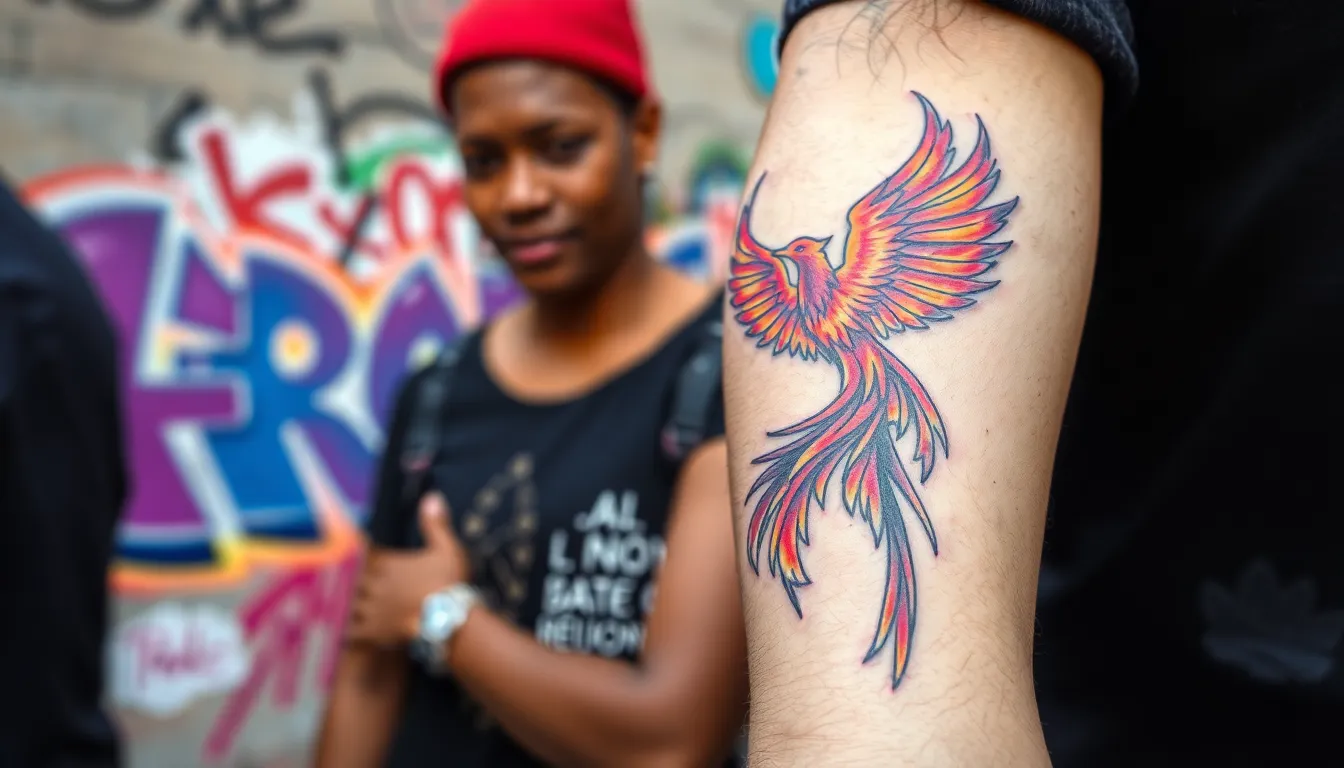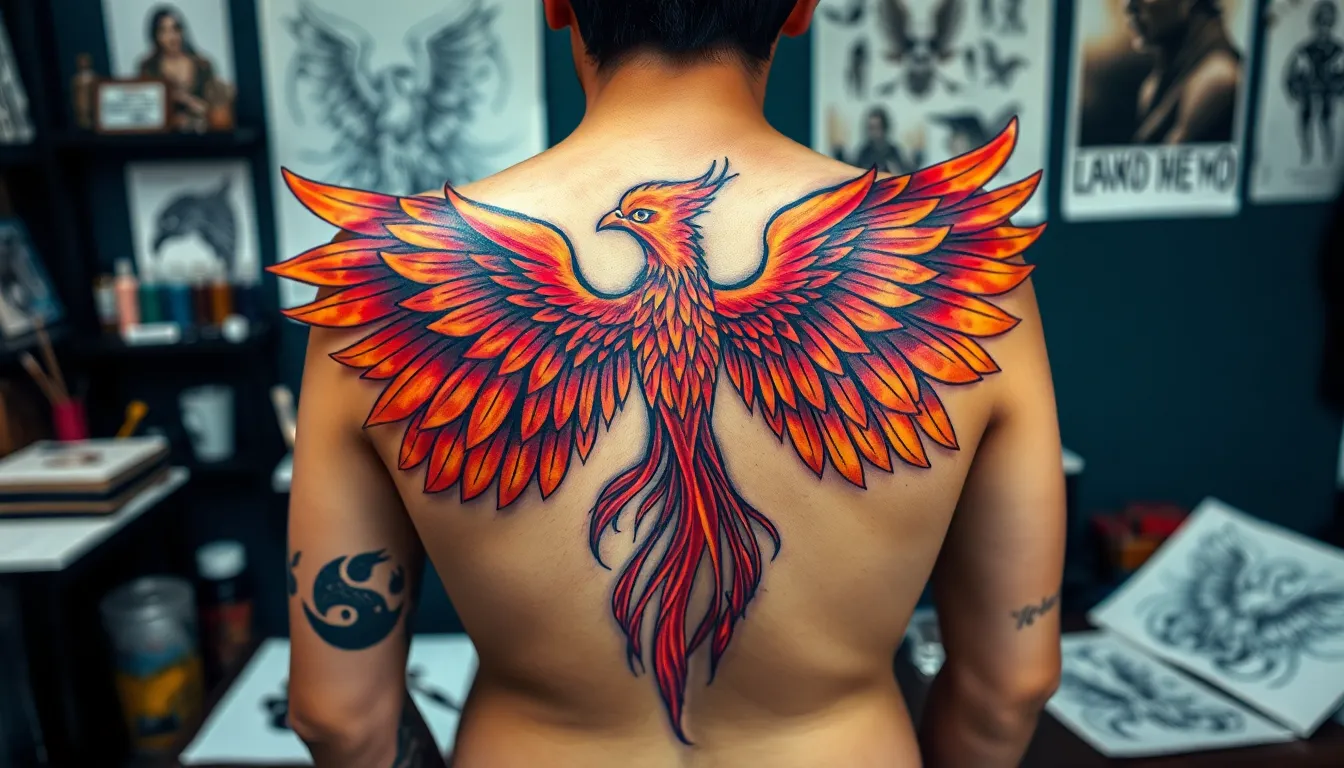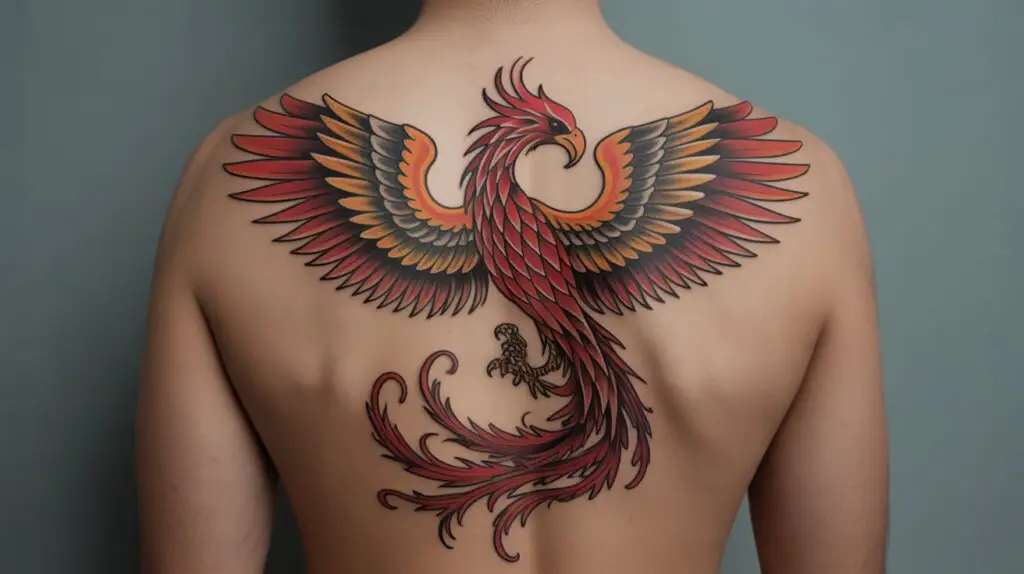Phoenix tattoos have captivated people across cultures for centuries, making them one of the most meaningful and visually striking designs in the tattoo industry. These magnificent mythical birds represent far more than just beautiful artwork – they carry profound symbolism that resonates with countless individuals seeking to mark important life changes or personal transformations.
When we see a phoenix tattoo, we’re witnessing someone’s declaration of resilience and rebirth. The legendary bird’s ability to rise from its own ashes speaks to our deepest human experiences of overcoming adversity, healing from trauma, and emerging stronger than before. This powerful symbolism makes phoenix tattoos incredibly personal and emotionally important choices.
Whether you’re considering your first tattoo or adding to an existing collection, understanding the rich symbolism behind phoenix designs can help you make an well-informed choice. We’ll explore the various meanings, cultural interpretations, and personal significance that make these fiery birds such compelling tattoo choices.
What Does a Phoenix Tattoo Symbolize
Phoenix tattoos carry profound symbolic meaning across cultures and personal experiences. The mythical bird represents transformation through fire, embodying the cycle of destruction and renewal that defines human resilience.
Core Symbolism of Phoenix Tattoos
Rebirth and Renewal form the foundation of phoenix symbolism. Ancient mythology depicts the phoenix consuming itself in flames every 500 years before rising from its own ashes. People choose phoenix tattoos to commemorate major life transitions like recovery from addiction, surviving trauma, or overcoming important challenges.
Strength and Resilience emerge as primary meanings for phoenix tattoo wearers. The imagery represents personal power gained through adversity. Survivors of cancer, depression, or life-altering events frequently select phoenix designs to symbolize their journey through darkness toward healing.
Spiritual Transformation connects phoenix tattoos to deeper metaphysical concepts. Eastern philosophies associate the phoenix with spiritual awakening and enlightenment. Buddhist and Hindu traditions view the bird as representing the soul’s journey through multiple lifetimes toward ultimate liberation.
Cultural Interpretations
| Culture | Phoenix Name | Primary Symbolism |
|---|---|---|
| Chinese | Fenghuang | Virtue, grace, prosperity |
| Greek | Phoenix | Immortality, resurrection |
| Egyptian | Bennu | Solar deity, creation cycles |
| Japanese | Ho-oh | Justice, fidelity, righteousness |
Chinese phoenix tattoos represent feminine power and imperial authority. The Fenghuang symbolizes the empress and complements the dragon’s masculine energy. Traditional Chinese phoenix designs incorporate five colors representing different virtues: red for loyalty, yellow for reliability, white for righteousness, black for wisdom, and green for benevolence.
Western phoenix interpretations focus on Christian resurrection themes and personal redemption. European phoenix mythology emphasizes the bird’s immortal nature and its connection to divine renewal. Modern Western phoenix tattoos often incorporate flames, wings, and rising imagery to represent overcoming personal struggles.
Personal Meaning Variations
Phoenix tattoos adapt to individual experiences and personal journeys. Recovery communities embrace phoenix imagery to represent sobriety milestones and addiction recovery. Mental health advocates use phoenix designs to symbolize healing from depression, anxiety, or PTSD.
Career transitions inspire phoenix tattoo choices for professionals reinventing themselves. Entrepreneurs starting new ventures, artists changing mediums, or individuals switching career paths select phoenix designs to mark their professional transformation.
Relationship healing motivates phoenix tattoo selection for people rebuilding after divorce, breakups, or family trauma. The phoenix represents emerging stronger from emotional devastation and creating healthier relationship patterns.
Modern Phoenix Tattoo Symbolism
Contemporary phoenix tattoos incorporate elements reflecting current social movements and personal empowerment. Feminist interpretations emphasize the phoenix as a symbol of women rising from patriarchal oppression. LGBTQ+ communities adopt phoenix imagery to represent coming out experiences and authentic self-expression.
Environmental activists use phoenix tattoos to symbolize Earth’s potential renewal even though climate challenges. The imagery represents hope for planetary healing and sustainable transformation of human behavior toward nature.
Social justice advocates incorporate phoenix designs to represent systemic change and community resilience. The phoenix symbolizes marginalized communities rising from historical oppression to claim their power and voice.
The Mythological Origins of the Phoenix

Ancient Egyptian mythology introduced the industry to the Bennu bird, the earliest known predecessor to the phoenix we recognize today. This sacred creature emerged from the primordial waters of creation, representing the soul of the sun god Ra and embodying the eternal cycle of death and rebirth that governed Egyptian cosmology.
Greek historians like Herodotus documented the phoenix legend around 450 BCE, describing a magnificent bird that lived for 500 years before constructing its own funeral pyre. Fire consumed the creature entirely, yet from the ashes arose a new phoenix, perpetuating an endless cycle of renewal that captivated ancient minds.
Egyptian Bennu Bird Origins
Sacred texts from ancient Egypt reveal the Bennu bird’s connection to the flooding of the Nile River, which brought life to the desert through annual cycles of destruction and regeneration. Temple walls in Heliopolis depicted this creature with a heron-like appearance, crowned with two long feathers that symbolized its divine nature.
Priests associated the Bennu with the morning sun, believing it sang the industry into existence each dawn through its celestial call. Creation myths positioned this bird as a self-generating deity, emerging from the heart of Osiris to establish the first land from chaotic waters.
Greek Phoenix Transformation
Classical Greek literature transformed the Egyptian Bennu into the phoenix, adding layers of symbolism that emphasized immortality and resurrection. Writers like Ovid detailed how the bird gathered aromatic woods and spices to build its nest, creating a fragrant pyre that would consume its aging body.
Phoenix mythology evolved to include exact timeframes ranging from 500 to 1,461 years, with each cycle representing cosmic renewal and divine intervention in mortal affairs. Roman authors later adopted these Greek interpretations, spreading phoenix symbolism throughout the Mediterranean industry and beyond.
Cross-Cultural Phoenix Variations
Chinese mythology presents the Fenghuang, often called the Chinese phoenix, which differs significantly from Western interpretations by embodying feminine power and imperial authority. Japanese culture features the Ho-oh, a phoenix variant that appears during peaceful reigns and symbolizes justice, fidelity, and righteousness.
| Culture | Phoenix Name | Primary Symbolism | Key Characteristics |
|---|---|---|---|
| Egyptian | Bennu | Solar rebirth | Heron-like, two feathers |
| Greek | Phoenix | Immortality | 500-year cycle, aromatic pyre |
| Chinese | Fenghuang | Feminine power | Imperial symbol, prosperity |
| Japanese | Ho-oh | Justice | Peaceful times, righteousness |
| Persian | Simurgh | Wisdom | Healing powers, divine knowledge |
Persian literature introduced the Simurgh, a massive phoenix-like bird possessing healing abilities and infinite wisdom gained through witnessing the destruction and recreation of the industry three times. Slavic folklore contributed the Firebird, whose glowing plumage could illuminate entire kingdoms and whose tears transformed into precious healing pearls.
These diverse mythological origins demonstrate how phoenix symbolism transcended geographic boundaries, adapting to reflect each culture’s unique values while maintaining core themes of renewal and transformation that continue to resonate in modern phoenix tattoo designs.
Core Symbolism of Phoenix Tattoos

Phoenix tattoo symbolism centers on three fundamental themes that resonate across cultures and personal experiences. These core meanings form the foundation for why individuals choose phoenix designs to represent their life journeys.
Rebirth and Renewal
Phoenix tattoos represent the powerful cycle of death and resurrection that defines the mythical bird’s legend. The phoenix rises from its own ashes after consuming itself in flames, creating a perfect metaphor for starting fresh after life’s most challenging moments. People often choose phoenix tattoos to mark important life transitions such as recovery from illness, divorce proceedings, or career changes.
This rebirth symbolism connects deeply with the ancient Egyptian Bennu bird mythology, where the phoenix represented the eternal cycle of sunrise and renewal. Modern interpretations expand this meaning to include spiritual awakening, personal reinvention, and the courage to leave behind destructive patterns. Phoenix tattoo designs frequently incorporate flames and rising imagery to emphasize this groundbreaking renewal process.
Overcoming Adversity
Phoenix tattoos symbolize the strength required to survive life’s most difficult challenges and emerge stronger. The mythical bird’s ability to endure complete destruction before resurrection mirrors human resilience in facing trauma, loss, and hardship. Individuals who’ve battled addiction, mental health struggles, or life threatening illnesses often select phoenix tattoos to commemorate their survival.
This adversity symbolism draws from the phoenix’s legendary immortality and its willingness to embrace destruction as part of its renewal cycle. The bird’s story demonstrates that strength isn’t avoiding difficulty but transforming pain into power. Phoenix tattoos serve as permanent reminders that we possess the capacity to rise above circumstances that once seemed insurmountable.
Transformation and Personal Growth
Phoenix tattoos embody the profound personal evolution that occurs through life experiences and conscious change efforts. The mythical bird’s metamorphosis from ashes to magnificent creature represents our ability to reinvent ourselves and reach new levels of wisdom and maturity. This symbolism appeals to individuals who’ve undergone important personal development journeys or major life transitions.
Transformation through phoenix tattoos extends beyond individual change to represent spiritual enlightenment and expanded consciousness. The Chinese Fenghuang tradition emphasizes this growth aspect, viewing the phoenix as a symbol of virtue development and moral elevation. Contemporary phoenix tattoo meanings include embracing authenticity, breaking free from limiting beliefs, and achieving personal empowerment through self discovery.
Cultural Interpretations Across Different Traditions

Phoenix tattoo symbolism varies dramatically across cultures, each tradition adding unique layers of meaning to this powerful mythological creature. We explore how different civilizations have shaped the phoenix narrative through their distinct cultural lenses.
Greek and Roman Mythology
Greek mythology presents the phoenix as a magnificent bird that lives for 500 years before creating a nest of aromatic spices and sacred wood. Ancient Greek historians like Herodotus documented this creature’s ability to burst into flames and emerge reborn from its own ashes. Roman interpretations expanded on this foundation, connecting the phoenix to themes of imperial power and eternal Rome.
Classical artwork depicts the phoenix with golden and red plumage, emphasizing its solar connections and divine nature. Greek philosophers used the phoenix as a metaphor for the soul’s immortality and the cyclical nature of existence. Roman coins often featured phoenix imagery during periods of political renewal, symbolizing the empire’s ability to overcome challenges and emerge stronger.
The Greco-Roman phoenix tattoo carries connotations of:
- Immortality and eternal life
- Solar worship and divine connection
- Philosophical contemplation of existence
- Imperial strength and renewal
Chinese and Asian Symbolism
Chinese culture presents the Fenghuang as a composite creature combining elements of multiple birds, representing the union of yin and yang energies. This mythical bird differs significantly from Western phoenix interpretations, embodying feminine power, virtue, and prosperity rather than rebirth through destruction.
Japanese mythology introduces the Ho-oh, a phoenix variant that appears only during peaceful and prosperous times. Buddhist traditions across Asia incorporate phoenix symbolism into concepts of enlightenment and spiritual awakening. Korean interpretations emphasize the phoenix’s role as a messenger between earthly and divine realms.
Asian phoenix tattoos typically symbolize:
- Feminine strength and imperial authority
- Harmonious balance between opposing forces
- Prosperity and good fortune
- Spiritual enlightenment and wisdom
Vietnamese culture associates the phoenix with the empress, while Thai traditions connect it to royal succession and divine mandate.
Modern Western Interpretations
Contemporary Western culture has transformed phoenix symbolism to reflect current social movements and personal empowerment narratives. Modern interpretations focus heavily on psychological rebirth and recovery from trauma, addiction, or mental health struggles.
Popular culture through movies, literature, and music has reinforced themes of resurrection and second chances. Social media platforms showcase phoenix tattoos as symbols of empowerment for marginalized communities, particularly women overcoming domestic violence and LGBTQ+ individuals celebrating their authentic identities.
Modern Western phoenix tattoos represent:
- Recovery from addiction and mental health challenges
- Feminist empowerment and breaking free from oppression
- LGBTQ+ pride and authentic self-expression
- Environmental activism and planetary renewal
- Career transitions and professional reinvention
Psychological interpretations emphasize the phoenix as a symbol of post-traumatic growth, where individuals transform their pain into strength. Therapeutic communities often encourage phoenix imagery as a visual representation of healing journeys and personal transformation.
Popular Phoenix Tattoo Design Elements and Their Meanings

Phoenix tattoo designs incorporate exact visual elements that amplify the mythical bird’s symbolic power. Each design component carries distinct meanings that enhance the overall message of transformation and renewal.
Rising Flames
Flames represent the destructive force that enables rebirth in phoenix tattoo designs. Fire elements typically appear as swirling patterns beneath or around the phoenix, symbolizing purification through adversity and the burning away of past limitations. Artists often incorporate flame details in red, orange, and gold tones to emphasize the groundbreaking heat that precedes resurrection.
The intensity of flame patterns reflects personal experiences with overcoming challenges. Bold, consuming fires suggest major life upheavals, while gentler flame wisps indicate gradual transformation processes. Phoenix flames also represent passion, creative energy, and the inner fire that drives personal growth.
Many designs position flames as ascending spirals, reinforcing the upward movement from destruction to renewal. These rising flame patterns create visual movement that guides the eye toward the phoenix’s emergence, emphasizing the triumphant nature of overcoming obstacles.
Spread Wings
Extended wings symbolize freedom, transcendence, and the moment of triumphant resurrection in phoenix tattoo art. Wing positioning conveys exact meanings: fully outstretched wings represent complete liberation from past constraints, while partially spread wings suggest ongoing transformation processes.
Feather details within wing designs carry cultural significance across different phoenix interpretations. Intricate feather work often incorporates decorative elements from Asian art traditions, while simplified wing shapes reflect modern minimalist approaches to phoenix symbolism.
Wing span proportions affect the tattoo’s visual impact and symbolic weight. Larger wings dominate the design space, emphasizing themes of power and majesty, while smaller wings focus attention on other design elements like flames or decorative patterns.
Color Symbolism
Color choices in phoenix tattoos communicate distinct symbolic messages that enhance the design’s personal meaning. Traditional color palettes draw from mythological descriptions and cultural associations with the phoenix legend.
| Color | Symbolic Meaning | Cultural Context |
|---|---|---|
| Red | Passion, life force, primal energy | Universal fire symbolism |
| Gold | Divine power, enlightenment, prosperity | Chinese Fenghuang tradition |
| Orange | Creativity, enthusiasm, transformation | Western phoenix interpretations |
| Purple | Spiritual awakening, mystery, nobility | Modern artistic variations |
| Blue | Healing, peace, emotional renewal | Contemporary therapeutic symbolism |
| Black | Death phase, shadow work, protection | Alchemical transformation |
Monochromatic phoenix tattoos in black and gray emphasize form and shading over color symbolism, focusing attention on line work and artistic technique. These designs often appeal to individuals who prefer subtle symbolic expression or want designs that age well over time.
Rainbow or multicolored phoenix designs represent diversity, LGBTQ+ pride, or the full spectrum of human experience. Contemporary artists frequently blend traditional color meanings with personal color preferences to create unique symbolic combinations.
Who Chooses Phoenix Tattoos and Why

Phoenix tattoos attract individuals from diverse backgrounds who share common experiences with transformation and resilience. We observe that people choose these designs during pivotal moments in their lives when they’ve overcome important challenges or undergone profound personal change.
Recovery and Healing Communities
Addiction recovery participants frequently select phoenix tattoos to commemorate their sobriety milestones. Cancer survivors embrace these designs to represent their triumph over illness and their renewed appreciation for life. Mental health advocates use phoenix imagery to symbolize their journey through depression, anxiety, or trauma recovery.
Career and Life Transition Seekers
Professionals experiencing major career shifts often choose phoenix tattoos to mark their professional rebirth. Divorced individuals select these designs to represent their emergence from difficult relationships as stronger, independent people. Parents who’ve overcome family challenges use phoenix symbolism to celebrate their resilience and growth.
Creative and Spiritual Communities
Artists and writers gravitate toward phoenix tattoos to represent their creative renaissance periods or artistic breakthroughs. Spiritual practitioners from various traditions choose these designs to symbolize their enlightenment journeys or religious transformations. Musicians and performers often select phoenix imagery to commemorate comeback moments in their careers.
Age and Gender Demographics
Adults aged 25-45 comprise the largest demographic choosing phoenix tattoos, as this life stage often involves important personal and professional transitions. Women select phoenix designs 60% more frequently than men, particularly drawn to the feminine power symbolism found in Chinese Fenghuang interpretations. Military veterans choose phoenix tattoos to represent their transition from service to civilian life and their resilience through combat experiences.
Cultural and Identity Expression
Individuals with mixed cultural heritage use phoenix tattoos to honor multiple traditions simultaneously, combining design elements from Greek, Chinese, or Persian phoenix variations. LGBTQ+ community members embrace phoenix symbolism to represent their coming out journeys or gender transitions. Social justice advocates select these designs to symbolize their commitment to creating positive change through adversity.
Placement and Style Considerations for Phoenix Tattoos

Phoenix tattoo placement significantly impacts both visual impact and personal meaning. Large phoenix designs work exceptionally well on the back, where the wingspan can extend across shoulder blades to create dramatic visual flow. Shoulder and arm placements allow for vertical compositions that follow the natural curve of limbs, making them popular choices for first time phoenix tattoos.
Strategic Body Placement Options
| Body Location | Design Advantages | Size Considerations |
|---|---|---|
| Full back | Maximum canvas for detailed wings | 8-12 inches wingspan |
| Shoulder/arm | Natural vertical flow | 6-8 inches length |
| Thigh | Large surface for complex designs | 6-10 inches height |
| Ribcage | Intimate personal placement | 4-6 inches width |
| Forearm | Visible daily reminder | 3-5 inches length |
Chest placements create powerful statements, particularly when the phoenix rises from the heart area upward toward the collarbone. This positioning reinforces themes of personal rebirth and emotional transformation that resonate with many phoenix tattoo recipients. Thigh tattoos offer substantial space for intricate details while maintaining privacy when desired.
Style Variations and Artistic Approaches
Realistic phoenix tattoos showcase detailed feather work and anatomical precision, requiring skilled artists experienced in wildlife portraiture. These designs typically feature 15-20 hours of tattooing time across multiple sessions. Traditional American style phoenix tattoos incorporate bold outlines and limited color palettes, creating timeless designs that age well over decades.
Watercolor phoenix tattoos blend soft edges with vibrant color transitions, mimicking painted artwork on skin. Japanese influenced designs integrate phoenixes with cherry blossoms, waves, and geometric patterns that reflect cultural aesthetics. Neo traditional styles combine classic tattoo elements with modern shading techniques and expanded color ranges.
Size and Complexity Guidelines
Small phoenix tattoos measuring 2-4 inches focus on simplified silhouettes and essential symbolic elements. Medium designs spanning 4-8 inches accommodate moderate detail levels including individual feathers and flame textures. Large phoenix tattoos exceeding 8 inches allow for comprehensive storytelling through multiple design elements and complex color work.
Minimalist phoenix designs use single continuous lines or geometric shapes to represent the mythical bird. These styles appeal to clients seeking subtle symbolism without overwhelming visual presence. Detailed realistic approaches require 3-6 months healing time between sessions for optimal color saturation and line work precision.
Artist Selection and Technical Requirements
Phoenix tattoos demand artists with exact skill sets including color theory knowledge and experience with large scale compositions. Portfolio reviews reveal an artist’s ability to handle feather textures, flame effects, and anatomical proportions essential for convincing phoenix imagery. Artists specializing in bird tattoos typically produce superior phoenix results compared to generalist tattooers.
Color phoenix tattoos require artists familiar with skin tone interactions and color longevity factors. Black and grey phoenix designs need expertise in contrast gradients and shadow work to create depth without color assistance. Session planning for complex phoenix tattoos involves 2-4 appointments spaced 4-6 weeks apart for proper healing.
Conclusion
Phoenix tattoos carry profound meaning that extends far beyond their stunning visual appeal. Whether you’re drawn to the ancient mythological origins or the modern interpretations of empowerment and social justice these designs offer a powerful way to commemorate your personal journey.
The beauty of phoenix symbolism lies in its universal resonance across cultures and generations. From the Egyptian Bennu to the Chinese Fenghuang each cultural interpretation adds depth to your tattoo’s significance while maintaining the core themes of resilience and renewal.
We’ve seen how these tattoos speak to people from all walks of life during their most groundbreaking moments. The choice to get a phoenix tattoo is deeply personal and marks a commitment to embracing change and celebrating your strength.
Your phoenix tattoo becomes a permanent reminder of your ability to rise above challenges and emerge stronger than before.
Frequently Asked Questions
What does a phoenix tattoo symbolize?
A phoenix tattoo symbolizes rebirth, renewal, and transformation through adversity. The mythical bird represents the powerful cycle of death and resurrection, making it a meaningful choice for those who have overcome significant life challenges, recovered from trauma, or undergone major personal growth. It embodies resilience, strength, and the ability to rise from difficult circumstances.
Who typically gets phoenix tattoos?
Phoenix tattoos attract diverse demographics, particularly adults aged 25-45 who have experienced pivotal life moments. Common recipients include addiction recovery participants, cancer survivors, individuals emerging from difficult relationships, and those undergoing career transitions. Artists, spiritual practitioners, and LGBTQ+ community members also choose phoenix designs to represent creative breakthroughs and identity expression.
What are the cultural meanings of phoenix tattoos?
Different cultures interpret phoenix tattoos uniquely. Greek and Roman traditions emphasize immortality and imperial strength, while Chinese culture views the Fenghuang as feminine power and spiritual balance. Japanese Ho-oh represents virtue and grace, and Persian Simurgh symbolizes wisdom. Modern Western interpretations focus on psychological rebirth, empowerment, and recovery from trauma.
Where is the best placement for a phoenix tattoo?
Phoenix tattoo placement depends on design size and personal preference. Large, detailed designs work best on the back, allowing full wingspan display. Shoulders and arms suit vertical compositions, while chest placements create powerful personal statements. Smaller designs can work on forearms or thighs. Consider visibility preferences and professional requirements when choosing placement.
What design elements enhance phoenix tattoo symbolism?
Key design elements include rising flames representing purification and transformation, extended wings symbolizing freedom and transcendence, and strategic color choices. Traditional palettes use red for passion, gold for divine power, and orange for energy. Monochromatic designs focus on form, while multicolored tattoos celebrate personal expression and diversity in the transformation journey.
How do I choose the right phoenix tattoo style?
Phoenix tattoo styles include realistic, traditional American, watercolor, and minimalist designs. Consider your personal aesthetic, skin tone, and desired symbolism. Realistic styles emphasize detail and natural beauty, while traditional designs offer bold lines and vibrant colors. Watercolor styles create artistic flow, and minimalist approaches focus on essential symbolic elements.
What should I consider before getting a phoenix tattoo?
Before getting a phoenix tattoo, research experienced artists skilled in large-scale compositions and color theory. Consider placement visibility for professional settings, design size relative to body area, and long-term commitment to the symbolism. Reflect on your personal transformation story and how the phoenix represents your journey to ensure meaningful connection.
Do phoenix tattoos have spiritual significance?
Yes, phoenix tattoos carry deep spiritual significance across various traditions. They represent spiritual transformation, enlightenment, and the soul’s journey through cycles of death and rebirth. Many spiritual practitioners choose phoenix designs to symbolize their awakening experiences, connection to divine power, and personal evolution through meditation, therapy, or religious practices.







